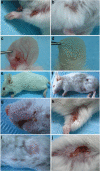Passive transfer of collagen XVII-specific antibodies induces sustained blistering disease in adult mice
- PMID: 23360583
- PMCID: PMC3582590
- DOI: 10.1186/1750-1172-8-17
Passive transfer of collagen XVII-specific antibodies induces sustained blistering disease in adult mice
Abstract
Background: Bullous pemphigoid is a subepidermal blistering disorder associated with tissue-bound and circulating autoantibodies directed mainly to the hemidesmosomal component collagen XVII. While recapitulating the main immunopathological features of the human disease, frank skin blistering does not develop in the absence of skin rubbing in experimental pemphigoid models that have been established in neonatal mice. Moreover, due to their experimental design they only allow for short-term disease observation. In the present study we aimed to establish a model that reproduces the frank skin blistering seen in patients and allows for longer observation times.
Methods: Rabbit and sheep antibodies specific to several fragments of collagen XVII were generated and the purified antibodies were passively transferred into adult mice.
Results: Collagen XVII-specific IgG bound to the basal membrane of the skin and mucous membranes activating murine complement in vivo. Mice injected with collagen XVII-specific antibodies, in contrast to mice receiving control antibodies, developed frank skin blistering disease, reproducing human bullous pemphigoid at the clinical, histological and immunopathological levels. Titres of circulating IgG in the serum of mice correlated with the extent of the clinical disease. Mice receiving sheep antibodies specific to murine collagen XVII showed an early onset and a more active disease when compared to litter mates receiving specific rabbit antibodies.
Conclusion: This novel animal model for bullous pemphigoid should facilitate further investigations of the pathogenesis of bullous pemphigoid and the development of innovative therapies for this disease.
Figures





Similar articles
-
The flavonoid luteolin inhibits Fcγ-dependent respiratory burst in granulocytes, but not skin blistering in a new model of pemphigoid in adult mice.PLoS One. 2012;7(2):e31066. doi: 10.1371/journal.pone.0031066. Epub 2012 Feb 6. PLoS One. 2012. PMID: 22328927 Free PMC article.
-
IgG antibodies against immunodominant C-terminal epitopes of BP230 do not induce skin blistering in mice.Hum Immunol. 2014 Apr;75(4):354-63. doi: 10.1016/j.humimm.2014.01.005. Epub 2014 Jan 24. Hum Immunol. 2014. PMID: 24468586
-
Pathogenesis of bullous pemphigoid.Immunol Allergy Clin North Am. 2012 May;32(2):207-15, v. doi: 10.1016/j.iac.2012.04.001. Epub 2012 Apr 17. Immunol Allergy Clin North Am. 2012. PMID: 22560134
-
Complement-independent blistering mechanisms in bullous pemphigoid.Exp Dermatol. 2017 Dec;26(12):1235-1239. doi: 10.1111/exd.13367. Epub 2017 Aug 29. Exp Dermatol. 2017. PMID: 28418613 Review.
-
Pathogenesis of bullous pemphigoid.Dermatol Clin. 2011 Jul;29(3):439-46, ix. doi: 10.1016/j.det.2011.03.008. Dermatol Clin. 2011. PMID: 21605809 Review.
Cited by
-
Deletion of the major bullous pemphigoid epitope region of collagen XVII induces blistering, autoimmunization, and itching in mice.J Invest Dermatol. 2015 May;135(5):1303-1310. doi: 10.1038/jid.2014.443. Epub 2014 Oct 13. J Invest Dermatol. 2015. PMID: 25310407
-
Pemphigoid disease model systems for clinical translation.Front Immunol. 2025 Mar 17;16:1537428. doi: 10.3389/fimmu.2025.1537428. eCollection 2025. Front Immunol. 2025. PMID: 40165962 Free PMC article. Review.
-
Complement-Activating Capacity of Autoantibodies Correlates With Disease Activity in Bullous Pemphigoid Patients.Front Immunol. 2018 Nov 20;9:2687. doi: 10.3389/fimmu.2018.02687. eCollection 2018. Front Immunol. 2018. PMID: 30524436 Free PMC article. Clinical Trial.
-
Peptide mimetics of immunoglobulin A (IgA) and FcαRI block IgA-induced human neutrophil activation and migration.Eur J Immunol. 2017 Oct;47(10):1835-1845. doi: 10.1002/eji.201646782. Epub 2017 Sep 6. Eur J Immunol. 2017. PMID: 28736835 Free PMC article.
References
-
- Bernard P, Vaillant L, Labeille B, Bedane C, Arbeille B, Denoeux JP, Lorette G, Bonnetblanc JM, Prost C. Incidence and distribution of subepidermal autoimmune bullous skin diseases in three french regions. Bullous diseases french study group. Arch Dermatol. 1995;131:48–52. doi: 10.1001/archderm.1995.01690130050009. - DOI - PubMed
Publication types
MeSH terms
Substances
LinkOut - more resources
Full Text Sources
Other Literature Sources

